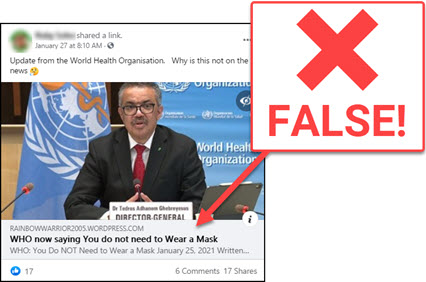The Sift: Vaccine disinfo | Fake GameStop tweet | Top editor turnover
Subscribe to the free weekly educator newsletter The Sift.
|
|
Teach news literacy this week |
|
Viral rumor rundown  NO: Baseball icon and civil rights activist Hank Aaron did not die as a result of taking the Moderna COVID-19 vaccine. YES: Aaron died of natural causes at the age of 86 on Jan. 22 — more than two weeks after receiving the vaccine on Jan. 5. NO: There has not been “a wave of suspicious deaths among elderly” people who recently received a vaccine, as this post from anti-vaccination activist Robert F. Kennedy Jr. claims. YES: Norway has registered 33 deaths since the end of December among people age 75 and over who received one dose of the vaccine. NO: Norway health officials found no evidence of a direct link between the deaths and the vaccine. YES: In Norway, about 45 people die every day in nursing homes.
 NO: The World Health Organization did not update its recommendations and say that “you do not need to wear a mask.” YES: This is a complete fabrication falsely claiming the statements were made by WHO officials at a Jan. 22 press conference.  NO: The verified Twitter account of the Black Lives Matter movement did not post this tweet. YES: It is a doctored image of a tweet in which the text has been altered: 
 NO: This is not an authentic tweet from SpaceX founder and Tesla CEO Elon Musk. YES: It is a fabricated screenshot of a fake tweet that was posted to r/WallStreetBets, the Reddit forum that helped drive up the price of GameStop stock in an attempt to execute a “short squeeze.” YES: Musk did energize the r/WallStreetBets Reddit page when he tweeted the word “Gamestonk,” referencing an internet meme, on Jan. 26.  NO: This is not an authentic Fox News headline. YES: It is a doctored screenshot in which the headline has been altered. |
 As local and regional newsrooms shrink, more news organizations rely on reporting from bigger outlets with a broader reach, including wire services, such as The Associated Press (AP) and Reuters. These “wires” help newsrooms provide stories from the wider world to their local audiences. Wire stories also help get information quickly to readers, as they are often among the first news reports available during breaking news events. |
 |
|
★ Sift Picks Featured “Search is on for new leaders in journalism’s upper echelons” (David Bauder, The Associated Press). Related:
Quick Picks “Trump Taught Teachers Conspiracy Theories. Now They’re Teaching Them To Students.” (Julia Reinstein, BuzzFeed News).
“Hospital incursions by Covid deniers putting lives at risk, say health leaders” (Ben Quinn and Denis Campbell, The Guardian).
Opinion: “Online Harassment Toward Women Is Getting Even More Insidious” (Nina Jankowicz, Wired).
“Spurred by Black Lives Matter, Coverage of Police Violence Is Changing” (Adeshina Emmanuel, Nieman Reports).
|
 |
|
What else did we find this week? Here's our list. |
|
Thanks for reading! Your weekly issue of The Sift is created by Peter Adams (@PeterD_Adams), Suzannah Gonzales and Hannah Covington (@HannahCov) of the News Literacy Project. It is edited by NLP’s Mary Kane (@marykkane). |
|

